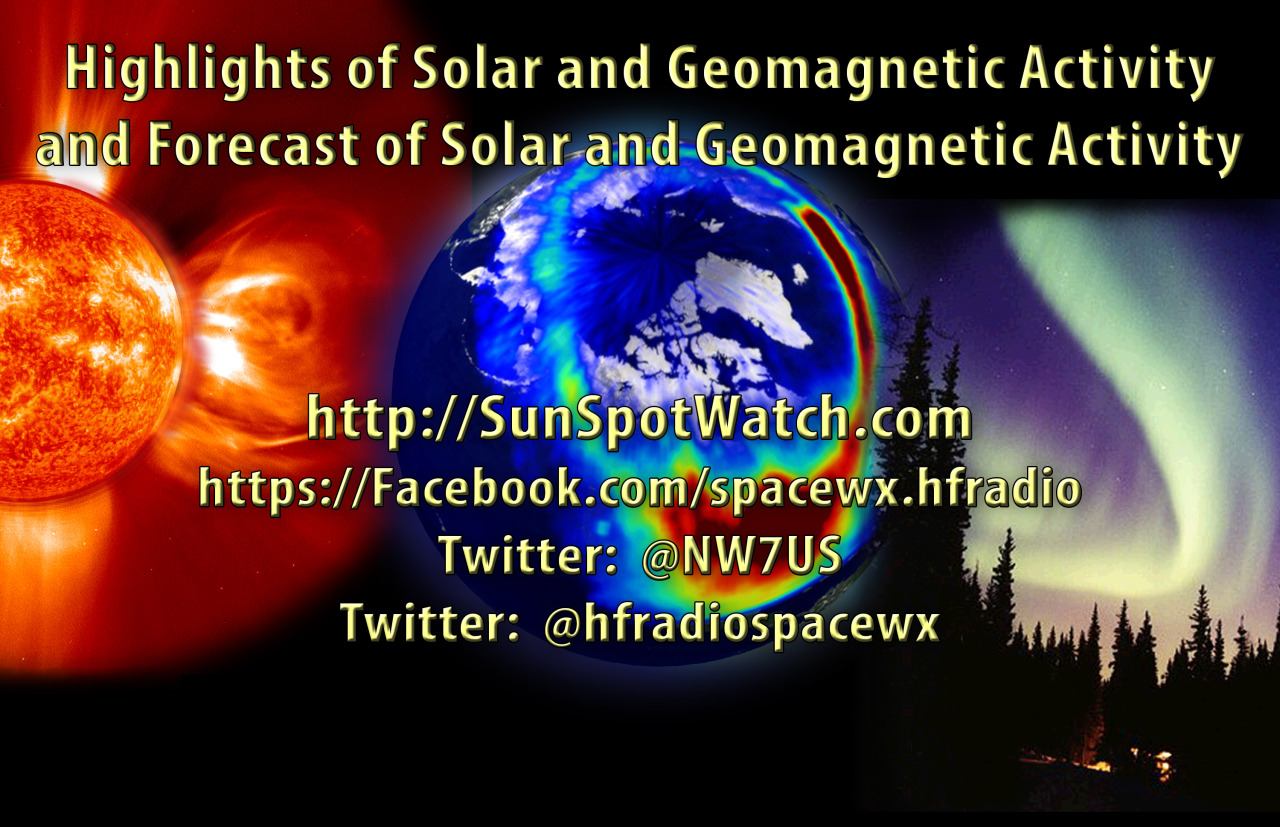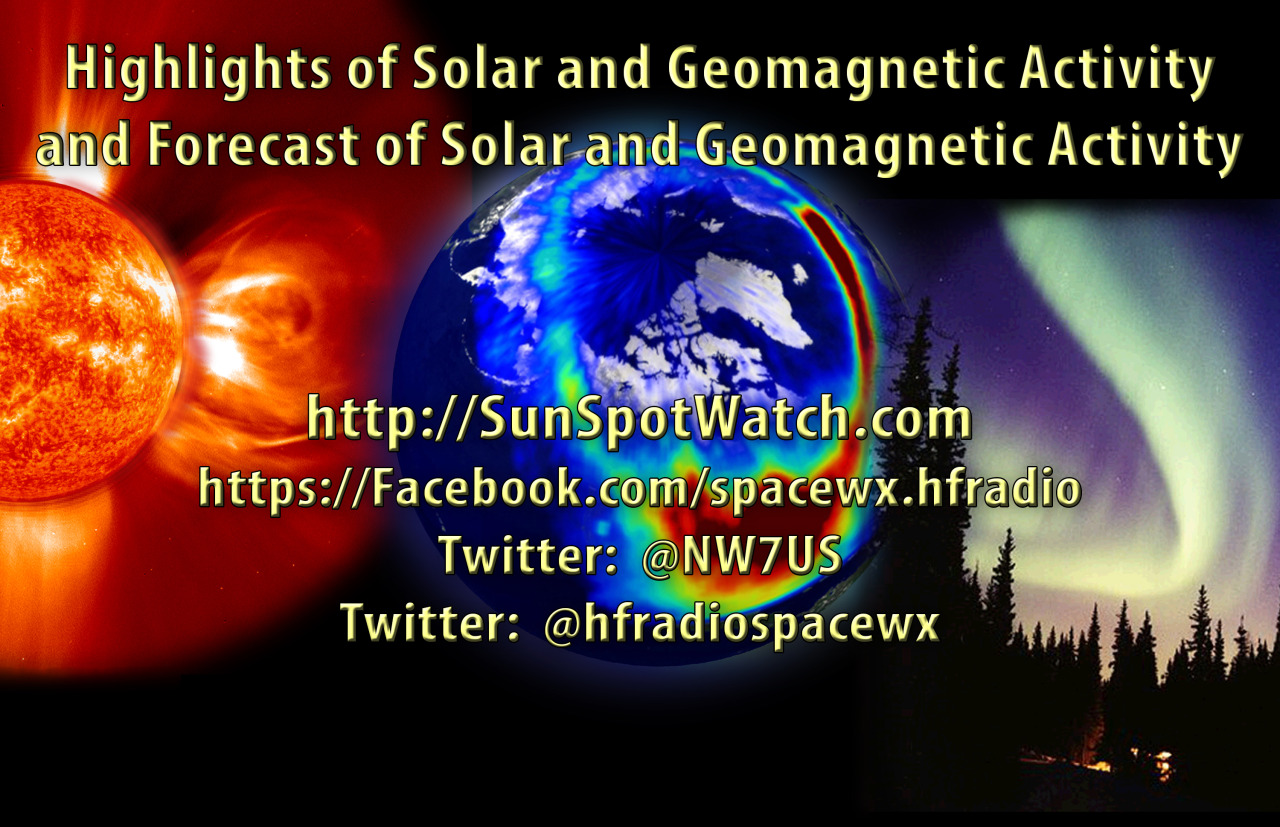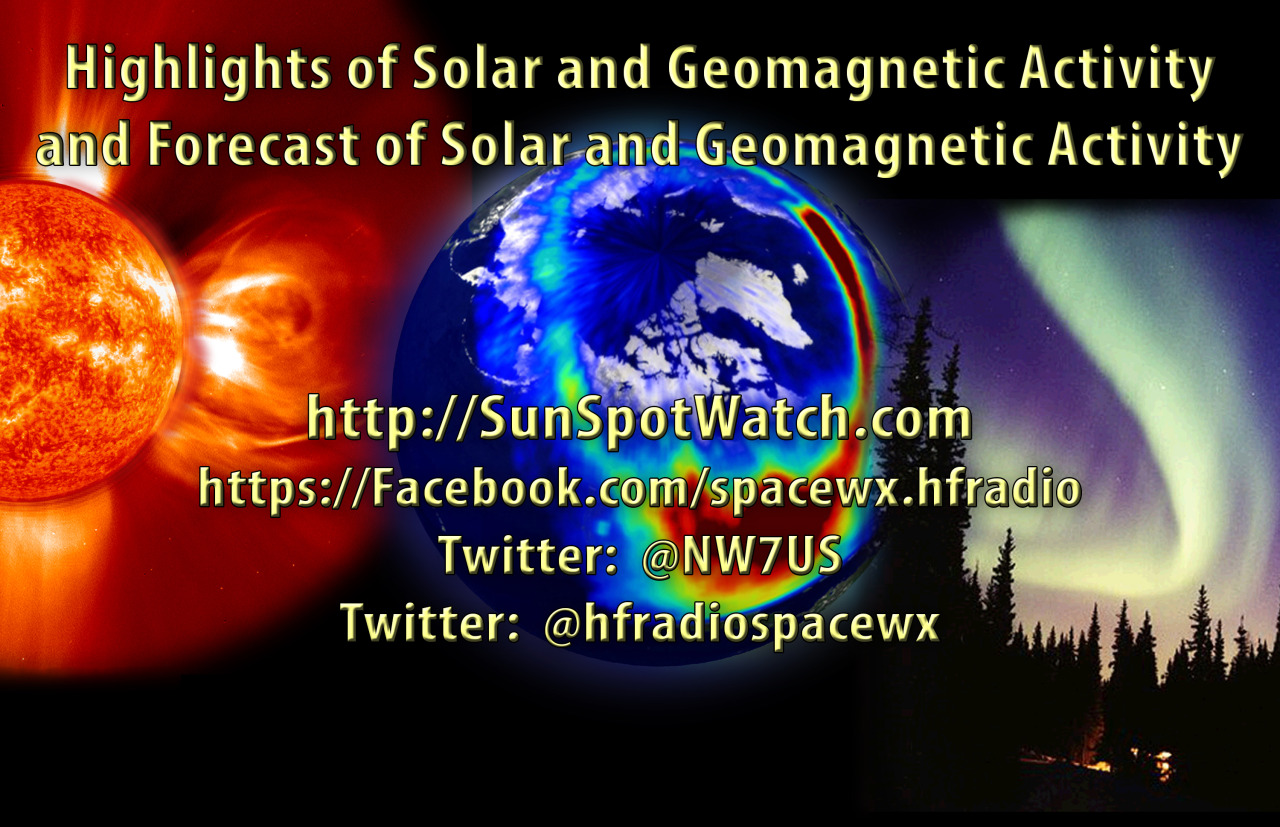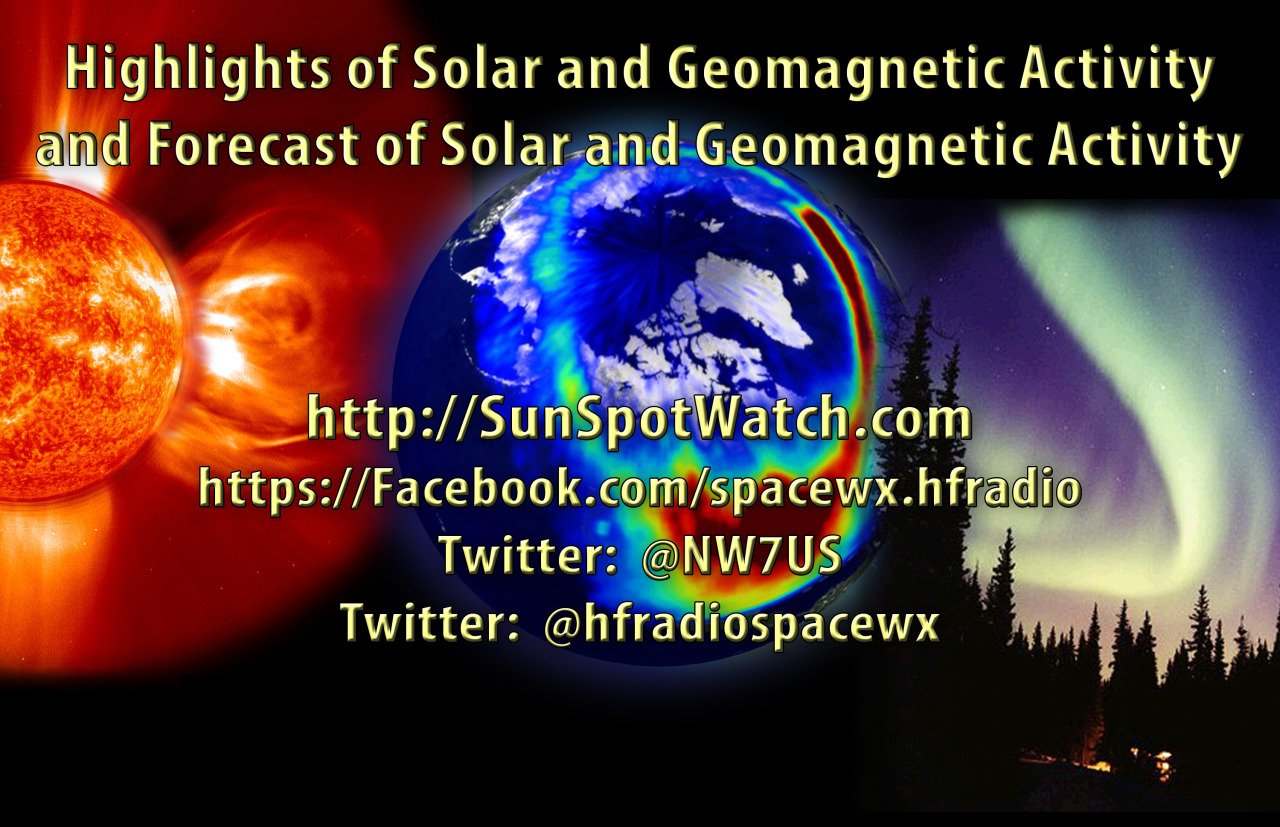Author Archive
 Weekly Propagation Summary – 2016 Jun 06 16:10 UTC
Weekly Propagation Summary – 2016 Jun 06 16:10 UTC
Here is this week’s space weather and geophysical report, issued 2016 Jun 06 0156 UTC.
Highlights of Solar and Geomagnetic Activity 30 May – 05 June 2016
Solar activity ranged from very low to low levels. Low activity was observed on 30 May with a pair of C1/Sf flares observed from Region 2550 (N15, L=114, class/area Cro/020 on 31 May). Very low levels were observed on 31 May and 01-05 Jun. Of note, the first spotless day since 17 Jul 2014 was observed on 03 Jun.
No proton events were observed at geosynchronous orbit.
The greater than 2 MeV electron flux at geosynchronous orbit was at high levels on 30 May – 04 Jun with moderate levels observed on 05 Jun.
Geomagnetic field activity ranged from quiet to minor storm (G1-Minor) levels. Quiet to active levels were observed on 30-31 May due to negative polarity coronal hole high speed stream (CH HSS) influence. During this time frame, wind speeds peaked at about 575 km/s early on 30 May while the Bz component of the interplanetary magnetic field reached a maximum southward of extent of -6 nT late on 31 May. Quiet conditions were observed on 01 Jun through midday on 05 Jun. Active to G1 storm levels were observed through the remainder of 05 Jun due to effects from another negative polarity CH HSS. Late on 05 Jun, wind speeds approached 650 km/s, total field reached 19 nT while the Bz component briefly hit a maximum southward extent of -15 nT.
Forecast of Solar and Geomagnetic Activity 06 June – 02 July 2016
Solar activity is expected to be at very low levels with C-class activity possible throughout the outlook period.
No proton events are expected at geosynchronous orbit.
The greater than 2 MeV electron flux at geosynchronous orbit is expected to be reach high levels on 07-09, 12-16, 26-30 Jun and 01 Jul. Normal to moderate levels are expected throughout the remainder of the outlook period.
Geomagnetic field activity is likely to reach G1 (Minor) levels on 06 Jun and 02 Jul with unsettled to active levels expected on 12-15, 17-18, 23-24 and 26-27 Jun, all due to the influence of multiple recurrent CH HSSs. Quiet to unsettled conditions are expected throughout the remainder of the outlook period under a nominal solar wind regime.
Don’t forget to visit our live space weather and radio propagation web site, at: http://SunSpotWatch.com/
Live Aurora mapping is at http://aurora.sunspotwatch.com/
If you are on Twitter, please follow these two users: + https://Twitter.com/NW7US + https://Twitter.com/hfradiospacewx
Get the space weather and radio propagation self-study course, today. Visit http://nw7us.us/swc for the latest sale and for more information!
Check out the stunning view of our Sun in action, as seen during the last five years with the Solar Dynamics Observatory (SDO): https://www.youtube.com/watch?v=zXN-MdoGM9g
We’re on Facebook: http://NW7US.us/swhfr
 Weekly Propagation Summary – 2016 May 30 16:10 UTC
Weekly Propagation Summary – 2016 May 30 16:10 UTC
Here is this week’s space weather and geophysical report, issued 2016 May 30 0216 UTC.
Highlights of Solar and Geomagnetic Activity 23 – 29 May 2016
Solar activity was very low on 23, 25, and 27-29 May with only background flare activity observed. Low levels of solar activity were observed on 24 May due to an isolated C1 flare from Region 2546 (S07, L=223, class/area=Cho/550 on 21 May) and on 26 May due to isolated C1 flares from Regions 2546 and 2548 (N13, L=171, class/area=Dsi/130 on 27 May). No Earth-directed coronal mass ejections were observed during the period.
No proton events were observed at geosynchronous orbit.
The greater than 2 MeV electron flux at geosynchronous orbit was at normal to moderate levels throughout the week.
Geomagnetic field activity was at quiet levels on 23 and 25-26 May and quiet to unsettled levels throughout the remainder of the period with an isolated period of active conditions observed on 28 May due to coronal hole high speed stream influence.
Forecast of Solar and Geomagnetic Activity 30 May – 25 June 2016
Solar activity is expected to be at very low levels with C-class flares possible throughout the outlook period.
No proton events are expected at geosynchronous orbit.
The greater than 2 MeV electron flux at geosynchronous orbit is expected to reach high levels on 05-07 and 12-16 Jun with normal to moderate levels expected throughout the remainder of the outlook period.
Geomagnetic field activity is likely to reach G1 (Minor) geomagnetic storm levels on 30 May and 05 Jun and active conditions are expected on 31 May and 06, 11-13, 17 and 24 Jun, all due to the influence of multiple recurrent coronal hole high speed streams. Quiet and quiet to unsettled conditions are expected throughout the remainder of the outlook period under a nominal solar wind regime.
Don’t forget to visit our live space weather and radio propagation web site, at: http://SunSpotWatch.com/
Live Aurora mapping is at http://aurora.sunspotwatch.com/
If you are on Twitter, please follow these two users: + https://Twitter.com/NW7US + https://Twitter.com/hfradiospacewx
Get the space weather and radio propagation self-study course, today. Visit http://nw7us.us/swc for the latest sale and for more information!
Check out the stunning view of our Sun in action, as seen during the last five years with the Solar Dynamics Observatory (SDO): https://www.youtube.com/watch?v=zXN-MdoGM9g
We’re on Facebook: http://NW7US.us/swhfr
 Weekly Propagation Summary – 2016 May 23 16:10 UTC
Weekly Propagation Summary – 2016 May 23 16:10 UTC
Here is this week’s space weather and geophysical report, issued 2016 May 23 0405 UTC.
Highlights of Solar and Geomagnetic Activity 16 – 22 May 2016
Solar activity was low with only B-class and C-class flare activity observed. Regions 2544 (N20, L=295, class/area=Dai/160 on 16 May) and 2546 (S07, L=223, class/area=Cho/550 on 21 May) produced three low-level C-class flares between them, with the largest being a C1.8 at 16/1525 UTC from Region 2544. No Earth-directed coronal mass ejections (CME) were observed during the reporting period.
No proton events were observed at geosynchronous orbit. However, there was a slight enhancement on 16 May from a long duration C3 flare that occured previous to the reporting period. The greater than 10 MeV proton flux reached a maximum of 1 pfu at 16/0030 UTC.
The greater than 2 MeV electron flux at geosynchronous orbit reached high levels on 16, 17, and 19 May and moderate levels on 18, 20-22 May.
Geomagnetic field activity was mostly at quiet to unsettled levels from 16-20 May with an isolated period of active conditions on 17 May in response to a positive polarity coronal hole high speed stream (CH HSS). G1 (Minor) geomagnetic storm levels were observed during the 0600-0900 UTC synoptic period on 21 May due to influences from another positive polarity CH HSS.
Forecast of Solar and Geomagnetic Activity 23 May – 18 June 2016
Solar activity is expected to be very low (B-class flares) to low (C-class flares) levels throughout the outlook period.
No proton events are expected at geosynchronous orbit.
The greater than 2 MeV electron flux at geosynchronous orbit is expected to reach high levels on 28-29 May, 01 Jun, 03-09 Jun, 12-13 Jun, and 18 Jun. Moderate flux levels are expected for the remainder of the outlook period.
Geomagnetic field activity is expected to reach G2 (Moderate) geomagnetic storm levels on 04 Jun and G1 (Minor) geomagnetic storm levels on 05 Jun due to the influence of a negative polarity CH HSS. Active geomagnetic levels are expected on 26 May, 30-31 May, 02-03 Jun, 06 Jun, 11-13 Jun, and 17-18 Jun due to various recurrent CH HSSs.
Don’t forget to visit our live space weather and radio propagation web site, at: http://SunSpotWatch.com/
Live Aurora mapping is at http://aurora.sunspotwatch.com/
If you are on Twitter, please follow these two users: + https://Twitter.com/NW7US + https://Twitter.com/hfradiospacewx
Get the space weather and radio propagation self-study course, today. Visit http://nw7us.us/swc for the latest sale and for more information!
Check out the stunning view of our Sun in action, as seen during the last five years with the Solar Dynamics Observatory (SDO): https://www.youtube.com/watch?v=zXN-MdoGM9g
We’re on Facebook: http://NW7US.us/swhfr
 Weekly Propagation Summary – 2016 May 16 16:10 UTC
Weekly Propagation Summary – 2016 May 16 16:10 UTC
Here is this week’s space weather and geophysical report, issued 2016 May 16 0334 UTC.
Highlights of Solar and Geomagnetic Activity 09 – 15 May 2016
Solar activity was low and only C-class flare activity was observed. Region 2543 (S05, L=002, class/area=Dao/90 on 10 May) produced a C7 flare at 14/1134 UTC which was the largest event of the period. Region 2544 (N21,L=296, class/area=Dao/150 on 15 May) produced five low-level C-class flares on 15 May, the largest being a C1 at 15/0502 UTC. Region 2542 (N12, L=357, class/area=Dai/150 on 09 May) produced a long-duration C3 flare at 15/1603 UTC with an associated filament eruption and partial-halo coronal mass ejection (CME) that departed off of the west limb. Forecaster analysis and WSA/Enlil modelling determined that the CME did not have an Earth-directed component. There were no Earth-directed CMEs during the period.
No proton events were observed at geosynchronous orbit. However, a slight enhancement was observed on 15 May associated with a long-duration C3 flare and filament eruption near Region 2542. A peak flux of 2 pfu was observed on 15 May at 2315 UTC.
The greater than 2 MeV electron flux at geosynchronous orbit was at very high levels from 09-13 May due to the influences of a negative polarity coronal hole high speed stream (CH HSS). High levels were observed on 14 May and moderate levels rounded out the week on 15 May.
Geomagnetic field activity was at unsettled to G3 (Strong) geomagnetic storm levels on 09 May due to the residual effects of a co-rotating interaction region and subsequent negative polarity coronal hole high speed stream (CH HSS). Mainly quiet to unsettled conditions were observed for 10-14 May with a nominal solar wind. A positive polarity CH HSS became connected with Earths magnetic field on 15 May causing quiet to active conditions.
Forecast of Solar and Geomagnetic Activity 16 May – 11 June 2016
Solar activity is expected to be at very low (B-class flares) to low (C-class flares) levels throughout the outlook period.
No proton events are expected at geosynchronous orbit.
The greater than 2 MeV electron flux at geosynchronous orbit is expected to be at high levels on 16-23 May, 30 May-02 Jun, and 06-10 Jun. Moderate flux levels are expected for the remainder of the period.
Geomagnetic field activity is expected to reach G1 (Minor) geomagnetic storm levels on 16, 19-20 May due to the influence of recurrent positive polarity coronal hole high speed streams (CH HSS). G1 (Minor) storm levels are also expected on 29 May and 04-05 June due to the influnce of negative polarity CH HSSs.
Don’t forget to visit our live space weather and radio propagation web site, at: http://SunSpotWatch.com/
Live Aurora mapping is at http://aurora.sunspotwatch.com/
If you are on Twitter, please follow these two users: + https://Twitter.com/NW7US + https://Twitter.com/hfradiospacewx
Get the space weather and radio propagation self-study course, today. Visit http://nw7us.us/swc for the latest sale and for more information!
Check out the stunning view of our Sun in action, as seen during the last five years with the Solar Dynamics Observatory (SDO): https://www.youtube.com/watch?v=zXN-MdoGM9g
We’re on Facebook: http://NW7US.us/swhfr
 Weekly Propagation Summary – 2016 May 09 16:10 UTC
Weekly Propagation Summary – 2016 May 09 16:10 UTC
Here is this week’s space weather and geophysical report, issued 2016 May 09 0436 UTC.
Highlights of Solar and Geomagnetic Activity 02 – 08 May 2016
Solar activity was low and only C-class flare activity was observed. Region 2540 (N21, L=068, class/area=Hrx/20 on 01 May) produced a C3 flare at 02/0842 UTC which was the largest event of the period. Region 2535 (N05, L=124, class/area=Hax/60 on 24 Apr) produced a C1 flare at 04/1531 UTC that had an associated Type II radio sweep (est. shock speed 560 km/s) and coronal mass ejection (CME). This CME was first observed in LASCO/C2 coronagraph imagery beginning 04/1412 UTC and likely arrived at Earth early on 08 May (see geomag section below for additional information). A pair of filament eruptions centered near N22E39 and N31E42 were observed in GONG imagery beginning at around 07/1515 UTC. The associated CME was first observed in LASCO/C2 imagery at 07/1648 UTC but analysis indicated that this CME was not Earth-directed.
No proton events were observed at geosynchronous orbit.
The greater than 2 MeV electron flux at geosynchronous orbit reached high levels on 03-06 May and moderate levels on 02, 07-08 May.
Geomagnetic field activity was at unsettled to G1 (Minor) geomagnetic storm levels on 02 May with quiet to active levels on 03 May due to the influence of a negative polarity coronal hole high speed stream (CH HSS). Quiet levels were observed on 04 May and quiet to unsettled levels were observed on 05 May under a nominal solar wind regime. The onset of a positive polarity CH HSS caused quiet to G1 (Minor) storm levels on 06 May and quiet to active levels on 07 May. On 08 May G1-G3 (Minor-Strong) geomagnetic storms were observed and analysis suggested that a CME (likely from 04 May as mentioned in solar activity section) was embedded in a CIR preceding a negative polarity CH HSS.
Forecast of Solar and Geomagnetic Activity 09 May – 04 June 2016
Solar activity is expected to be at very low (B-class flares) to low (C-class flares) levels throughout the outlook period.
No proton events are expected at geosynchronous orbit.
The greater than 2 MeV electron flux at geosynchronous orbit is expected to reach very high levels on 10-13 May and high levels on 09, 14, and 30 May-02 Jun. Moderate flux levels are expected for the remainder of the period.
Geomagnetic field activity is expected to be reach G3 (Strong) geomagnetic storm levels on 09 May and G1 (Minor) storm levels on 10 May due to the influence of a negative polarity coronal hole high speed stream (CH HSS). G1 (Minor) storm levels are likely on 20 May due to the influence of a positive polarity CH HSS as well as on 29 May and 04 Jun due to the influence of negative polarity CH HSSs.
Don’t forget to visit our live space weather and radio propagation web site, at: http://SunSpotWatch.com/
Live Aurora mapping is at http://aurora.sunspotwatch.com/
If you are on Twitter, please follow these two users: + https://Twitter.com/NW7US + https://Twitter.com/hfradiospacewx
Get the space weather and radio propagation self-study course, today. Visit http://nw7us.us/swc for the latest sale and for more information!
Check out the stunning view of our Sun in action, as seen during the last five years with the Solar Dynamics Observatory (SDO): https://www.youtube.com/watch?v=zXN-MdoGM9g
We’re on Facebook: http://NW7US.us/swhfr
 Weekly Propagation Summary – 2016 May 02 16:10 UTC
Weekly Propagation Summary – 2016 May 02 16:10 UTC
Here is this week’s space weather and geophysical report, issued 2016 May 02 0421 UTC.
Highlights of Solar and Geomagnetic Activity 25 April – 01 May 2016
Solar activity was reached low levels this period. A total of seven low-level C-class flares were observed through the week, four of which were from Region 2535 (N05, L=124, class/area=Hax/60 on 24 Apr) and the remaining three were from Region 2539 (N16, L=084, class/area=Eai/100 on 01 May). A pair of coronal mass ejections (CMEs) associated with flare activity from Region 2535 were observed in LASCO C2 coronagraph imagery at 28/0216 UTC and 28/0636 UTC, but did not impact Earth as anticipated.
No proton events were observed at geosynchronous orbit.
The greater than 2 MeV electron flux at geosynchronous orbit reached moderate levels on 25-30 Apr and was at normal levels on 01 May.
Geomagnetic field activity was quiet on 25, 28-29 Apr, quiet to unsettled on 26-27, 30 Apr, and quiet to active on 01 May.
Forecast of Solar and Geomagnetic Activity 02 May – 28 May 2016
Solar activity is likely to be low with a slight change for M-class flares (R1-R2 (Minor-Moderate) Radio Blackouts) on 03-16 May due to return of old Region 2529 (N09, L=342) which produced an isolated M6 flare (R2-Moderate Radio Blackout) last rotation. Very low to low levels of solar activity are likely through the remainder of the period.
No proton events are expected at geosynchronous orbit.
The greater than 2 MeV electron flux at geosynchronous orbit is likely to reach high levels on 11-13 May with normal to moderate levels expected for the remainder of the outlook period.
Geomagnetic field activity is expected to reach G1-G2 (Minor-Moderate) geomagnetic storm levels on 02 May due to an enhanced solar wind environment and prolonged southward magnetic field orientation. G1 (Minor) geomagnetic storms are likely on 11 and 20 May with active levels likely on 10, 12, 14, 19 and 21 May due to the influence of recurrent coronal hole high speed streams (CH HSSs). Quiet to unsettled field activity is expected throughout the remainder of the period.
Don’t forget to visit our live space weather and radio propagation web site, at: http://SunSpotWatch.com/
Live Aurora mapping is at http://aurora.sunspotwatch.com/
If you are on Twitter, please follow these two users: + https://Twitter.com/NW7US + https://Twitter.com/hfradiospacewx
Get the space weather and radio propagation self-study course, today. Visit http://nw7us.us/swc for the latest sale and for more information!
Check out the stunning view of our Sun in action, as seen during the last five years with the Solar Dynamics Observatory (SDO): https://www.youtube.com/watch?v=zXN-MdoGM9g
We’re on Facebook: http://NW7US.us/swhfr
 Weekly Propagation Summary – 2016 Apr 25 16:10 UTC
Weekly Propagation Summary – 2016 Apr 25 16:10 UTC
Here is this week’s space weather and geophysical report, issued 2016 Apr 25 0446 UTC.
Highlights of Solar and Geomagnetic Activity 18 – 24 April 2016
Solar activity was high on 18 Apr due to an M6/1f flare observed at 18/0029 UTC from old Region 2529 (N09, L=342, class/area Eki/850 on 11 Apr). Type II (1869 km/s) and Type IV radio sweeps were observed in conjunction with this event, as well as a 120 sfu Tenflare. Activity dropped to low levels on 19 Apr with a C1/Sf observed at 19/2302 UTC. Very low levels were observed for the remainder of the period after the region departed the disk.
No proton events were observed at geosynchronous orbit.
The greater than 2 MeV electron flux at geosynchronous orbit was at normal to moderate levels throughout the period.
Geomagnetic field activity was mostly quiet on 18-21 Apr. Quiet to unsettled conditions were observed on 22-24 Apr. Isolated active periods were observed on 22 and 24 Apr along with an isolated minor storm period on 23 Apr due to CH HSS effects.
Forecast of Solar and Geomagnetic Activity 25 April – 21 May 2016
Solar activity is expected to be very low to low for the majority of the period with a chance for M-class flares from 03-16 May due to the return of old Region 2529.
No proton events are expected at geosynchronous orbit.
The greater than 2 MeV electron flux at geosynchronous orbit is expected to be at normal to moderate levels with the exception of 01-03 May and 10-13 May following recurrent CH HSS events.
Geomagnetic field activity is expected to be quiet to unsettled on 25-26 Apr as CH HSS effects subside followed by quiet conditions on 27-28 Apr. Quiet to unsettled conditions are expected on 29 Apr to 01 May with active periods likely due to effects from a recurrent, negative polarity CH HSS. An isolated minor storm period is possible on 30 Apr. Mostly quiet conditions are expected on 02-08 May with unsettled to active periods possible on 04 May due to a SSBC. Quiet to active levels are expected on 09-11 May with minor storm periods likely due to negative polarity CH HSS effects. Mostly quiet conditions are expected from 12-18 May. Isolated unsettled to active periods are possible on 14 May due to another SSBC. Quiet to unsettled conditions are expected from 19-21 May with isolated active periods possible due to effects from a recurrent, positive polarity CH HSS.
Don’t forget to visit our live space weather and radio propagation web site, at: http://SunSpotWatch.com/
Live Aurora mapping is at http://aurora.sunspotwatch.com/
If you are on Twitter, please follow these two users: + https://Twitter.com/NW7US + https://Twitter.com/hfradiospacewx
Get the space weather and radio propagation self-study course, today. Visit http://nw7us.us/swc for the latest sale and for more information!
Check out the stunning view of our Sun in action, as seen during the last five years with the Solar Dynamics Observatory (SDO): https://www.youtube.com/watch?v=zXN-MdoGM9g
We’re on Facebook: http://NW7US.us/swhfr



















